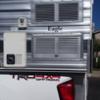2017 New season for New Owners. Many of which are new to truck camping. The following is an answer I provided on a "PM" last year:
Battery Honeymoon period
Honeymoon because my experience is battery very efficient until year 1.5 till 2 years old. Then the voltage drops by 25% just sitting.
When we owners started using compressor fridges (2011-2012) we had no idea how in-efficient they were (especially the Dometics and all front loading fridge/freezer combo units). The factory specs don't give you "running amps" just average maintaining amps. Your fridge published specs show it using 3.75 amps per hour. The actual usage of the Dometic 65L is 4.5 - 5 amps when cycling. So how can a fridge twice the size draw less?? Answer: it can't.
Four Wheel has replaced the Dometics with "ISOTHERM" models which are much more efficient than the Dometics.
4-Light LED monitor and your batteries
Batteries
New they easily hold 80% of the charge with alternator topping them off. After two years the ability to maintain a reserve declines and the discharge faster. We thought our single camper battery was enough to run the fridge, fan, LED lights and charge the plane batteries...and it was just barely. if we didn't run the fan too much....and we ran the engine twice a day.
Camping in one place for 2 days or more had us adding a 60 watt portable. solar panel. Producing 3.5 amps per hour just running the portable Engle fridge (1.5 amp) per hour, the lights (1-2 amp) two hours a day and charging the model airplane batteries.
We had to add a 1.25 amp charger/maintainer to run the fridge and maintain the battery the night before we left on a trip.
In the regular camper run the IOTA the night before. With two batteries you have 80 usable amps. If your average amp draw is 7 amps per hour (fridge and rest of it) you have 11-14 hours before needing to charge. (In winter depending on your Latitude you will experience over 12 hours of darkness per day.)
Your 4-LED light battery monitor is inefficient Testing by others with a Trimetric or other battery monitor have proven the "full batteries actually only 75% full". .Overtime the percent of full on each recharge will be less. Knowing "full" voltage is not enough. You need to know amps in and out and percentage of charge.
History
Initially (2012) we all got 2 solar plugs - one on roof, one on back wall and most of us just used portable panels as panels don't work in the shade. figuring the alternator would run the fridge and charge the battery while going down the road. Problem is when your parked, engine off sight seeing, hiking away from your rig.
The absorption owners switch to propane when parked for a long time. When we park the fridges draw current from the batteries. I figured when I got to the campground (no hookups) for the evening the battery would be full. After installing the Trimetric I saw that wasn't true. Many times percentage of full was less than 90%..
What happens when the battery gets below 12 volts?
The Sure Power disconnects the truck from the camper to protect the truck battery from being discharged. The only way to get the batteries over 12 volts (connect to the alternator for charging) is through the 110 volt house current or through Solar. If you are 20 miles away or more from 110 hookup all the food in your fridge will spoil because fridge won't run if the voltage is below 12 volts.
That is the reason we all added roof solar.
Adding Solar
is easy because your camper is prewired for it standard...except the rear wall solar plug is an option. Be sure you order it. The factory installs the ZAMP system as an option. Or "Do-It-Yourself" and save about $500. They bolt the panel on the roof. Connect cable it to the connector. Connect other end to the solar controller. Run wire from controller to the batteries and your done. . Buy at least 150 watts for the roof. 150 watts produce 5.1 amps in the winter when the sun is low and 9.1 amps in summer when sun is high in the sky. because the panel cannot be tilted toward the sun. Monitor the amps in and out and percentage of full on Trimetric.
The Zamp controller displays the battery voltage, what the solar is producing, and what the draw is.
(fridge, lights on, fan on etc…). It does NOT display alternator or 110 volt in. or percentage of full.
Zamp is expensive and has limitations. If you are handy with tools "You can do-it-yourself" and save $500. Our current 150 watt roof panel ($200) plus Trimetric (;$250) plus installation ($75) plus controller ($50) plus misc parts cost $600 plus my labor.
Review my post "Fleet/Eagle amateur Build".- Electrical section. I have a lot of info on my shell build that pertains to the regular camper. As a retired computer tech and retired industrial sales person, I was a sustaining resource" to my customers, I love to research and share the info.
Getting to know your camper is a process. The FWC factory folks and their very well trained dealers are a great resource for your questions. as are the contributors in Wander the West.
Happy New truck camping.
Edited by RC Pilot Jim, 30 June 2017 - 02:30 PM.
















